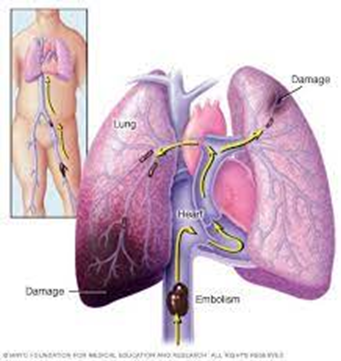A nurse is caring for a client in the intensive care unit who was admitted with severe head trauma and cerebral edema. The client opens their eyes spontaneously, is oriented, and obeys commands. Which of the following findings indicate the client is experiencing a decline in their condition?
(Select All that Apply.)
Client responds to name
Eyes open to painful stimuli
Client states day of the week
Client is confused
Client mumbles inappropriate words
Eyes do not open to name
Correct Answer : B,D,E,F
Choice A Reason:
Client responds to name is incorrect. Responding to one's name is a positive sign indicating consciousness and orientation. It suggests that the client's level of consciousness is relatively intact.
Choice B Reason:
Eyes open to painful stimuli is correct. Opening the eyes in response to painful stimuli is a concerning sign, indicating a decrease in consciousness and potentially worsening neurological status. It suggests that the client's level of arousal is diminishing and may indicate a decline in condition.
Choice C Reason:
Client states day of the week is correct. Oriented behavior, such as knowing the day of the week, is a positive sign indicating intact cognition and orientation. It suggests that the client's mental status is relatively preserved.
Choice D Reason:
Client is confused is correct. Confusion is a concerning sign, indicating altered mental status and potentially worsening neurological function. It suggests that the client's cognition is impaired, which may be indicative of a decline in condition.
Choice E Reason:
Client mumbles inappropriate words is correct. Mumbling inappropriate words suggests disorientation and altered mental status, which are concerning signs indicating a decline in neurological function.
Choice F Reason:
Eyes do not open to name is incorrect. Failure to open the eyes in response to verbal stimuli, such as one's name, is a concerning sign indicating a decrease in consciousness and potentially worsening neurological status. It suggests that the client's level of arousal is diminished and may indicate a decline in condition.
Nursing Test Bank
Naxlex Comprehensive Predictor Exams
Related Questions
Correct Answer is D
Explanation
Correct answer: D
Choice A Reason:
Decreased pulmonary vascular resistance is incorrect. Inflammatory mediators released in response to a pulmonary embolism can lead to vasoconstriction and increased pulmonary vascular resistance. This is part of the body's response to redirect blood flow away from the affected area of the lung and maintain adequate perfusion to other areas.
Choice B Reason:
Hypercapnia is incorrect. Hypercapnia refers to elevated levels of carbon dioxide (CO2) in the blood.Hypocapnia usually is present with embolism; hypercapnia, on the other hand, is rare.
Choice C Reason:
Hypoventilation is incorrect. Hypoventilation occurs when there is inadequate ventilation of the lungs relative to metabolic demands. In the context of a pulmonary embolism, hypoventilation can occur due to factors such as pain, respiratory muscle fatigue, or impaired gas exchange, all of which can be influenced by the release of inflammatory mediators.
Choice D Reason:
Respiratory alkalosis is correct.In response to the blockage and the resulting inflammation, the body often increases the respiratory rate as a compensatory mechanism to maintain adequate oxygen levels and remove carbon dioxide.Due to the increased breathing rate, there is excessive exhalation of carbon dioxide, leading to a decrease in the partial pressure of CO2 in the blood. This results in an increase in blood pH, causing respiratory alkalosis.

Correct Answer is B
Explanation
Choice A Reason:
Manual wheelchair is inappropriate. A manual wheelchair requires the use of the client's upper extremities to propel the wheelchair forward by pushing on the wheels. With a spinal cord injury at the fourth cervical level, the client may have limited or no function in their upper extremities, making it difficult to self-propel a manual wheelchair.
Choice B Reason:
Sip-and-puff device is appropriate. A sip-and-puff device allows individuals with limited or no hand function to control a powered wheelchair using their breath. This device enables the client to navigate the wheelchair by inhaling or exhaling into a straw-like device, which activates controls to move the wheelchair forward, backward, and turn.
Choice C Reason:
Drive-adapted wheelchair is inappropriate. A drive-adapted wheelchair is a powered wheelchair that can be modified with adaptive controls to accommodate individuals with limited hand function or mobility. These wheelchairs may include joystick controls, head arrays, chin controls, or other adaptive devices that allow the client to operate the wheelchair independently despite limited hand function.
Choice D Reason:
Ultra-light wheelchairs is inappropriate. Ultra-light wheelchairs are manual wheelchairs that are lightweight and often customized to fit the client's specific needs and preferences. While ultra-light wheelchairs may offer advantages in terms of maneuverability and ease of transportation, they still require sufficient upper extremity function to self-propel the wheelchair.
Whether you are a student looking to ace your exams or a practicing nurse seeking to enhance your expertise , our nursing education contents will empower you with the confidence and competence to make a difference in the lives of patients and become a respected leader in the healthcare field.
Visit Naxlex, invest in your future and unlock endless possibilities with our unparalleled nursing education contents today
Report Wrong Answer on the Current Question
Do you disagree with the answer? If yes, what is your expected answer? Explain.
Kindly be descriptive with the issue you are facing.
